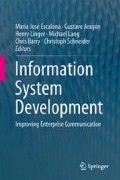Abstract
In multidisciplinary engineering projects the effective and considerate propagation of changes is essential to ensure a consistent view of the project and to minimize defects and risks. To achieve this, the changes coming from one discipline need to be communicated and coordinated with the participants of the disciplines where those changes are relevant. In this paper, we introduce a user-centric context-adaptive notification manager (UCAN), which makes use of modelling techniques at design and runtime to derive effective change notifications that are delivered in a considerate manner. We present a prototype implementation of UCAN based on industry use cases and discuss its benefits and limitations based on the feedback from industry partner domain experts.
Access this chapter
Tax calculation will be finalised at checkout
Purchases are for personal use only
Notes
- 1.
OWL Web Ontology Language (OWL)—www.w3.org/TR/owl-ref/
- 2.
- 3.
Semantic Web Rule Language (SWRL)—http://www.w3.org/Submission/SWRL/
References
Winkler D, Moser T, Mordinyi R, Sunindyo WD, Biffl S (2011) Engineering object change management process observation in distributed automation systems projects. In: EuroSPI 2011, IEEE, pp 1–10
Lüder A, Estévez E, Hundt L, Marcos M (2011) Automatic transformation of logic models within engineering of embedded mechatronical units. Int J Adv Manuf Tech 54:1077–1089
Gibbs WW (2005) Considerate computing. Sci Am 292(1):54–61
Schäfer W, Wehrheim H (2007) The challenges of building advanced mechatronic systems. In: 2007 Future of Software Engineering, IEEE, pp 72–84
Hehenberger P, Egyed A, Zeman, K (2010) Consistency checking of mechatronic design models. In: ASME and IDETC/CIE 2010 conferences, pp 1–8
Egyed A (2011) Automatically detecting and tracking inconsistencies in software design models. IEEE Trans Software Eng 37(2):188–204
Ramchurn SD, Deitch B, Thompson MK, Roure DCD, Jennings NR, Luck M (2004) Minimising intrusiveness in pervasive computing environments using multi-agent negotiation. In: MOBIQUITOUS 2004, pp 364–372
Calvary G, Coutaz J, Thevenin D, Limbourg Q, Bouillon L, Vanderdonckt J (June 2003) A unifying reference framework for multi-target user interfaces. Interact Comput 15(3):289–308
Clerckx T, Vandervelpen C, Coninx K (2008) Task-based design and runtime support for multimodal user interface distribution. In: Engineering interactive systems. Springer, Berlin, Heidelberg, pp 89–105
Blumendorf M, Lehmann G, Albayrak S (2010) Bridging models and systems at runtime to build adaptive user interfaces. In: EICS 2010, ACM, pp 9–18
Gil M, Giner P, Pelechano V (2012) Personalization for unobtrusive service interaction. Pers Ubiquit Comput 16(5):543–561
Moser T, Biffl S (2012) Semantic integration of software and systems engineering environments. IEEE Trans Syst Man Cybern C Appl Rev 42(1):38–50
Gruber TR (1993) A translation approach to portable ontology specifications. Knowl Acquis 5:199–220
Serral E, Valderas P, Pelechano V (2013) Context-adaptive coordination of pervasive services by interpreting models during runtime. Comput J 56(1):87–114
Batory D (2005) Feature models, grammars, and propositional formulas. In: International software product line conference. Lecture notes in computer science, vol 3714, p 720
Zaid LA, Kleinermann F, De Troyer O (2009) Applying semantic web technology to feature modeling. In: SAC 2009, ACM, pp 1252–1256
Biffl S, Schatten A (2009) A platform for service-oriented integration of software engineering environments. In: Proceedings of the 2009 conference on new trends in software methodologies, tools and techniques, pp 75–92
Author information
Authors and Affiliations
Corresponding author
Editor information
Editors and Affiliations
Rights and permissions
Copyright information
© 2014 Springer International Publishing Switzerland
About this paper
Cite this paper
Serral, E., Mordinyi, R., Biffl, S. (2014). Effective and Considerate Change Notifications in Multidisciplinary Engineering Projects. In: José Escalona, M., Aragón, G., Linger, H., Lang, M., Barry, C., Schneider, C. (eds) Information System Development. Springer, Cham. https://doi.org/10.1007/978-3-319-07215-9_36
Download citation
DOI: https://doi.org/10.1007/978-3-319-07215-9_36
Published:
Publisher Name: Springer, Cham
Print ISBN: 978-3-319-07214-2
Online ISBN: 978-3-319-07215-9
eBook Packages: Computer ScienceComputer Science (R0)

